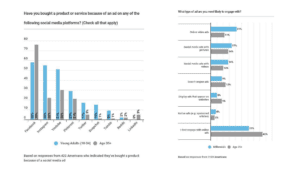Although it took them a while, millennials have finally entered the retail auto market, and they’ve entered in force. According to industry research, 35% of all auto loans came from the Millennial demographic, and from 2012 to 2016, their share of all lease contracts grew by 49%. And an impressive 24% of Millennials aged 18-29 said they intended to buy a new car in the next 12 months, which was tops among all age groups. That’s a whole lot of potential customers to be captured, if you can just reach them.

So how do you connect with this vital demographic? If you know anything about Millennials, you know the simple answer is “the internet.” But, of course, it’s more complicated than that. Let’s parse some of the numbers from Clever Real Estate’s latest marketing study of millennials to see what the data can tell us.
Where Do Digital Natives Live?
Millennials use far more digital resources than older age groups to conduct research before they buy a vehicle, visiting an average of 18 different sites before they even step foot in a dealership.
Clearly, this is when you want to get in front of their eyeballs. But how?
Location is one key. Social media is an increasingly important site of online marketing, and Facebook is still the dominant social media channel overall. But this is less true when it comes to Millennials.


More and more, Millennials are migrating to other social media channels like Instagram and Youtube. Part of this is because recent Facebook scandals have corroded their trust in the tech giant, and part of it is simply the novelty effect. But if you want to reach Millennials, you’ll have to go where they are, and increasingly, that isn’t Facebook.
This isn’t as much of an inconvenience for us as it might seem initially. That’s because, in the wake of privacy complaints, Facebook has removed many of its Partner ad targeting features, meaning that you can no longer use data-driven behavioral targeting to market directly to people based on their purchase histories. Particularly, the ability to target consumers who intend to purchase a car, SUV, or truck in the next 30 to 180 days has been removed.
The loss of these precision targeting tools makes Facebook a much less valuable marketing platform, whether you’re trying to reach millennials or any other age group. This isn’t to say Facebook advertising should be abandoned all together, but automotive marketers need to look into other online platforms.
First Impressions Are More Important Than Ever
Wherever you engage with them, striking the right tone is an important consideration. Emotionally manipulative ads don’t work on this demographic; surveys show they prefer funny (43%) or straightforwardly informative (29%) advertisements. Keep it light-hearted and simple.
Instagram and YouTube are also worth investing in, because Millennials are more likely to engage with online video ads, social media ads with pictures, and social media ads with video.
Visual mediums like YouTube and Instagram are the perfect opportunity for automotive marketers to show off the latest and greatest models. Think fresh paint jobs, roaring engines, and aggressive trims.
Finally, the framing and presentation of your message is going to be as important, or maybe even more important, than the message itself, which is to say that aesthetics really matter to millennials. A lot. According to our study, 92% of millennials said that a website or app’s appearance was important to them in deciding whether or not to submit their personal information.
It’s simple, really: you must look legitimate to win the trust of millennials.
Millennials want to trust you: you just have to earn it.








